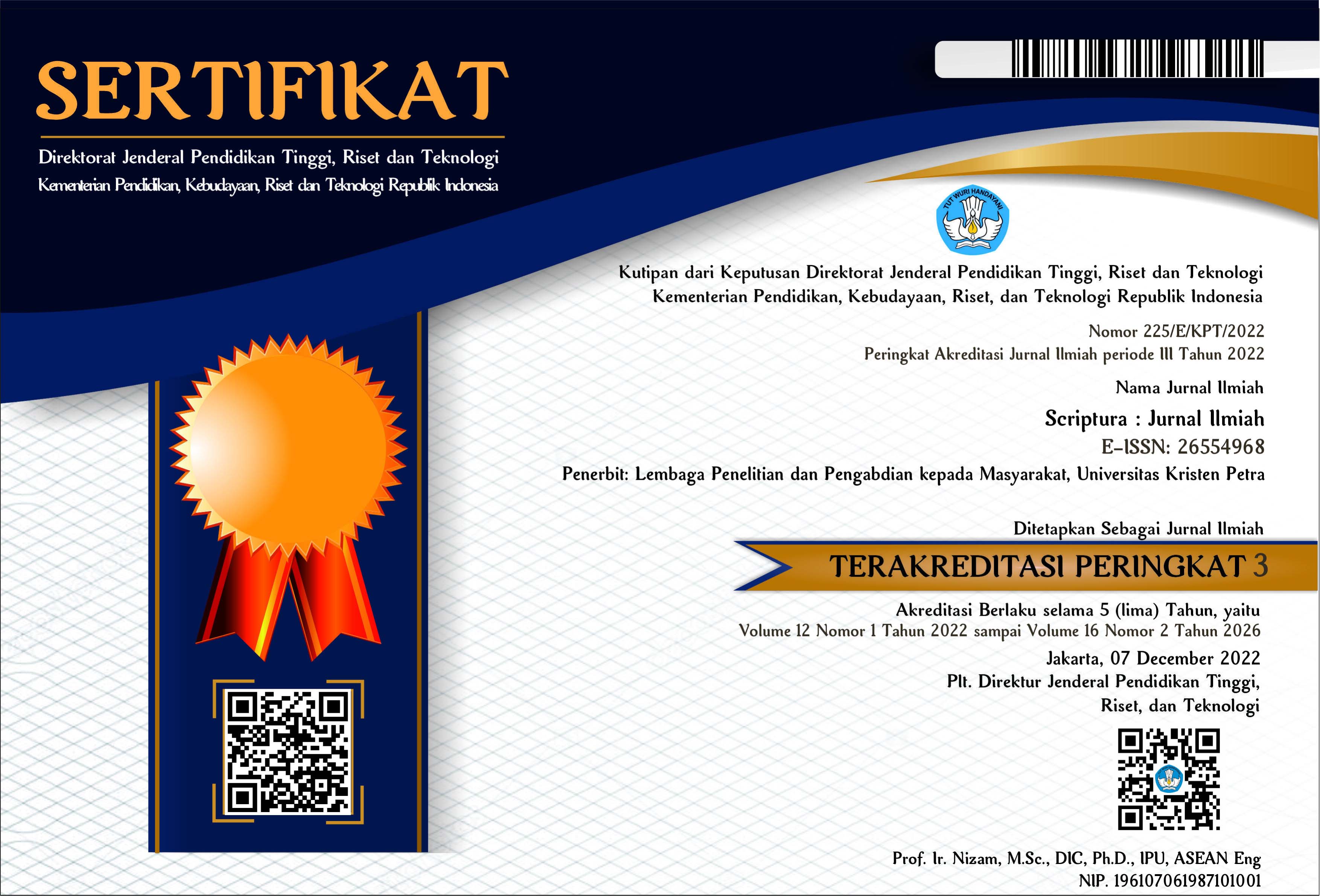GAZA IN MEDIA EDITORIAL FRAME (SUARA PEMBARUAN, MEDIA INDONESIA, AND REPUBLIKA)
 :
:
https://doi.org/10.9744/scriptura.3.2.172-187
Keywords:
Media frame, editorial, ideology.Abstract
Gaza strip has became the home for the longest lasting conflict between Israel and Palestine, even when the researcher doing this research, the conflict still remain. This conflict has become an important issue for the international world and has attracted various media coverage from all over the world including Indonesia. Many news, opinions, and editorials are involved in expressing arguments of different interests. Moreover, Indonesia has the largest Moslem population in the world, and therefore the conflict is often brought into the religious realm. Medias with different ideologies produce their reports with different frames. It is no surprise that people may have different perception about a situation in the conflict. This phenomenon, is the reason behind the writers interest in finding out how the Gaza conflict is being framed in Indonesian media editorial. Framing Analysis Method is being used to find out the differences of framing between the following medias: Suara Pembaruan (SP), Media Indonesia (MI), and Republika. It is found that differences in ideology influenced the framing of media editorial. Suara Pembaruan builds a frame that shows that Palestine (Hamas) is an extreme cluster causing negative effects, while Israel and United Nations’s resolution viewed from a positive point of view. MI sees this conflict as political conflict. Republika perceives this conflict as an impact of Israel violence as well the paralyzed condition of the United Nation.References
Antara Zionisme dan Yahudi. Retreive 12 Oktober 2009, from http://www. harunyahya. com/indo/artikel/046.htm.
Berger, P. L., 2007. Sociology as a form of consciousness invitation to sociology, from http://www.angelfire.com/or/sociologyshop/berger2.html.
Devereux, E., 2003. Understanding the media. London: SAGE.
Edward, H. S., Shomsky, N., 1988. Manufacturing concent the political economy of the mass media. London: Vintage.
Eriyanto, 2007. Analisis framing: Konstruksi, ideologi, dan politik media. Yogyakarta: PT LKIS Pelangi Aksara.
Fenny, 2009. Membongkar ideologi media cetak pada tajuk rencana penyerangan massa AKKBB oleh FPI di lima koran nasional Indonesia. (TA No: 20010447/ KM/2009). Universitas Kristen Petra Surabaya.
Flick, U., 1998. An introduction to qualitative research. London: SAGE.
Gandhi, T. W., 2009. Akar konflik Israel-Palestina: Tinjauan demografi, sejarah, geopolitik, dan agama. Yogyakarta: Ramadhan Press.
Goodman, A., Goodman, D., 2006. Perang demi uang, from http://www.parasindonesia.com/book.php?gid=s.
Hamad, I., 2004. Konstruksi realitas politik dalam media massa. Jakarta: Granit.
Kamus besar bahasa Indonesia, 2000. Jakarta: Balai Pustaka.
Kadri, 2006. Ideologi dan media massa, Jurnal Ilmiah Communigue, Vol 2, No.2.
Lichtenberg, J., 2002. Foundations and limits of freedom of the press. (Denis Mcqual). London: SAGE.
Lippman, W., 1992. Stereotypes, public opinion, ang the press. (Elliot D. Cohen, Ed.). New York: Oxford University Press.
Littlejohn, S. W., Fos, A. F., 2005. Theories of human communication. Canada: Wadsworth.
Masduki, 2001. Jurnalistik radio. Yogyakarta: PT LKIS Pelangi Aksara.
Membedakan Zionisme dari Yahudi, Retreive 20 Oktober 2009, from http://www. harunyahya.com/indo/artikel/049.htm
Moleong, L. J., 2005. Metodologi penelitian kualitatif. Bandung: PT Remaja Rosda-karya.
Mulyana, D., 2005. Ilmu komunikasi, suatu pengantar. Bandung: Remaja Rosda-karya.
Nimmo, D., 1993. Komunikasi politik: Komunikator, pesan, dan media. (Tjun Surja-man). Bandung: Remaja Rosdakarya.
Panjaitan, G., 2008. Konstruksi pemberitaan tentang perang antar Israel dan Hezbullah–Lebanon. Unpublished Undergraduate Thesis, Airlangga University, Surabaya.
Panuji, R., 2005. Dasarnya dasar jurnalistik. Malang: Banyumedia
Santanak, S., September 2002. Politik bisnis media. Library unisba.co.id, Retrieved September 3, 2002, from http://library.unisba.co.id/artikel/artikel-sept-030902-doc.
Scheufele, D. A., Tewksbury, D., 2007. Framing, agenda setting, and primity: the evolution of three media effect models. International Communication. Journal Communication.
Shoemaker, P. J., Reese, S. D., 1996. Mediating the message–Theories of influences on mass media content. USA: Logman Publisher.
Siburian, S. P., 2007. Pers dan pemilihan presiden di Indonesia, analisis framing Isu demokratisasi dalam tajuk rencana Kompas, Suara Pembaruan, Republika, dan Jawa Pos pada pemilihan presiden 2004. (TA No. KKB KK-2 TSK 01/07 Sib P). Unpublished Undergraduate Thesis, University Airlangga, Surabaya.
Stovall, J. G., 2005. Jounalism who, what, when, where, why, and how, from Pearson Education, Inc.
Subiakto, H., 1997. Dominasi negara dan wacana pemberitaan pers dalam masya-rakat dan negara (Bambang Susilo, Ed.). Surabaya: Airlangga University Press.
Amerika Serikat adalah Israel http://kristolog.blogspot.com/2009/03/amerika-serikat-adalah-israel.html.
www.infoanda.com/linksfollow.php?lhVQ8PVVBVUAdU.
Profil Republika, Retreived 12 Oktober 2009. www.republika.co.id/halaman/23.
Downloads
Published
How to Cite
Issue
Section
License
Authors who publish in the SCRIPTURA Jurnal Ilmiah agree to the following terms:
Authors retain unrestricted copyright and full publishing rights. The authors grant the Publisher the right of first publication, with the work simultaneously licensed under the terms and conditions of the Creative Commons Attribution License (CC BY) that allows for unlimited use, distribution, and content reproduction on all media as long as the original author and source are properly acknowledged and cited.

















